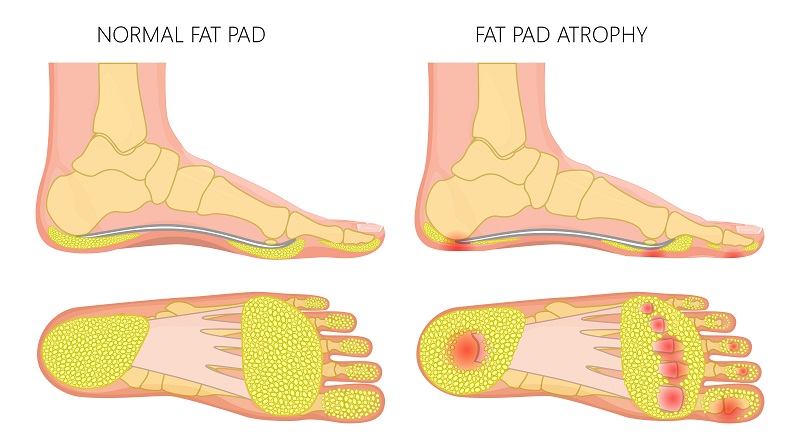Fat Pad Atrophy Anatomy
- The fat pads are exactly what their name describes, adipose (fatty) tissue that is located on the bottom of the foot, under the heel and under the ball of the foot.
What Does Fat Pad Atrophy Do?
- The fat pad is designed to absorb shock when weight bearing protecting bones, tendons, blood vessels, ligaments, and nerves from shearing and compressive forces that can result in a heel bone bruise or eventually a fracture.
- A normal healthy fat pad measures 1-2 cm of thickness. Anything under 1 cm is considered abnormal.
- It is important to know that fat pad atrophy is the second leading cause of heel pain following plantar fasciitis.
How Does Fat Pad Atrophy Happen?
- 6 times more prevalent in women than in men (for unknown reason)
- There are microchambers (superficial) and macro-chambers (deep) that are made up of fatty tissue. Depending on the amount of atrophy, a person can be symptomatic or asymptomatic.
- When both the superficial layers and the deep layers are damaged, a person will typically have pain with walking.
- The fat pad has a normal tendency to degenerate with age and activity. By age 50, an average individual has walked 75,000 miles and will lose 50% of their fat pad as a result(2).
- Other factors that may increase the risk of fat pad atrophy include:
- Occupations and lifestyles that require standing on hard non-natural surfaces
- Diabetes
- Obesity (if not in proper protective shoewear)
- Neuropathy
- Rheumatoid Arthritis
- Vascular disease
- Autoimmune conditions
- Collagen disorders
- Chronic corticosteroid use, particularly injected in the heel
- Long distance runners due to impact and the number of steps in their lifetime
- Trauma
- Walking in very thin-soled shoes or long term use of high heels
- Orthopedic conditions that can lead to fat pad atrophy:
- Hammertoes
- High arches
- Fracture in the foot or ankle
- Downward displaced metatarsal head
- Morton’s Neuroma
- Plantar fasciitis
Fat Pad Atrophy Symptoms
- Heel pain with palpation (the bony bump on the bottom of the heel should not be able to be palpated through a normal fat pad)
- Ball of foot pain with weight-bearing, wedge or high heeled shoes
- Pain with standing, particularly on hard non-natural surfaces (such as tile or cement)
- Pain with walking when the heel strikes the ground
- Barefoot walking is most painful
- May present with thick calluses on the heel or ball of foot
Articles Related to Fat Pad Atrophy
Currently, there are very limited surgical/structural fixes for the fat pad. Researchers are working on finding ways to increase collagen production through various fillers such as liquid silicone and adipose (fat) tissue from one’s own body. Osteotomies and resections have been done but with little success. To date, the most beneficial practices for management of fat pad atrophy are with conservative measures.
- Fat Grafting Improves Foot Pain Associated with Fat Pad Atrophy of the Heel: Early Findings from a Randomized Controlled Clinical Trial https://www.ncbi.nlm.nih.gov/pmc/articles/PMC5959632/
- Management of Painful Fat Pad Atrophy http://lermagazine.com/article/management-of-painful-plantar-fat-pad-atrophy
Twin Cities Fat Pad Atrophy Physical Therapy
If you are experiencing any symptoms of Fat Pad Atrophy please contact us today to set up your appointment with a Minnesota physical therapist. We have physical therapy clinics located in Minneapolis and Edina.

